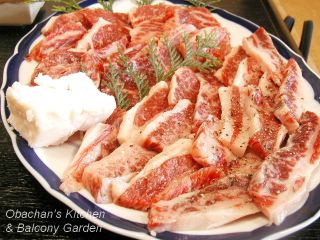|
Sunday, May 29, 2005
Ume (Japanese Plum) Jam
Posted by
obachan
at
5/29/2005 09:45:00 PM
12
comments
![]()
Labels: Jam/Marmalade
Saturday, May 28, 2005
Dolce! - Tiramisu -
|
Posted by
obachan
at
5/28/2005 06:02:00 PM
14
comments
![]()
Thursday, May 26, 2005
After One Terrible Night -- Tomato-flavored Rice Porridge --
|
Posted by
obachan
at
5/26/2005 08:54:00 PM
10
comments
![]()
Labels: Rice dish
Wednesday, May 25, 2005
Chocolate-Tofu Pudding
Well, I guess it’s about time she went back to the U.S. and had some spare time to spend in front of her computer, so now I’m posting this entry. |
Posted by
obachan
at
5/25/2005 12:50:00 AM
13
comments
![]()
Monday, May 23, 2005
Eki-Ben
|
Posted by
obachan
at
5/23/2005 04:47:00 PM
8
comments
![]()
Labels: Bento
Dinner with fish fish and Patrick
On Sat. 21st, I visited Kansai and met fish fish and another blogger, Patrick at the Hub in Kyoto. She already posted about our dinner with better food pics than mine. Thanks fish fish!! |
Posted by
obachan
at
5/23/2005 03:11:00 PM
7
comments
![]()
Yakiniku!!
|
Posted by
obachan
at
5/23/2005 02:04:00 PM
5
comments
![]()
Thursday, May 19, 2005
Leftovers, Leftovers, Leftovers...
It is something inevitable as far as I’m living all by myself…LEFTOVERS. I still had the edamame (green soybeans), daikon, mentaiko, kinome-miso and Japanese yam left from the virtual kaiseki weekend. |
Posted by
obachan
at
5/19/2005 01:20:00 AM
10
comments
![]()
Wednesday, May 18, 2005
Best Thing I've Ever Made! - Konatsu Marmalade -
|
Posted by
obachan
at
5/18/2005 12:09:00 AM
10
comments
![]()
Labels: Jam/Marmalade
Tuesday, May 17, 2005
Panna Cotta with Cherry Sauce
|
Posted by
obachan
at
5/17/2005 12:20:00 AM
4
comments
![]()
Sunday, May 15, 2005
Obachan's Quasi-Kaiseki
OK, it’s time to show the world the result of my ill-thought project that took me all-afternoon Friday and all day Saturday this weekend. Wondering what this is? This is “quasi-Kaiseki” by a middle-aged woman in Kochi who had nothing better to do this weekend. |
Posted by
obachan
at
5/15/2005 01:26:00 PM
13
comments
![]()
Mizugashi (Dessert)
|
Posted by
obachan
at
5/15/2005 01:00:00 PM
6
comments
![]()
Tome-Wan (Rice, Miso Soup and Pickles)
|
Posted by
obachan
at
5/15/2005 12:59:00 PM
3
comments
![]()
Labels: Rice dish
Sunomono (Vinegared Dish)
|
Posted by
obachan
at
5/15/2005 12:58:00 PM
3
comments
![]()
Nimono (Simmered Dish)
|
Posted by
obachan
at
5/15/2005 12:56:00 PM
4
comments
![]()
Labels: Simmered dish
Agemono (Deep-fried Dish)
|
Posted by
obachan
at
5/15/2005 12:55:00 PM
3
comments
![]()
Labels: Deep-fried dish
Yakimono (Broiled Dish)
|
Posted by
obachan
at
5/15/2005 12:54:00 PM
3
comments
![]()
Labels: Fish
Sashimi (Sliced Raw Fish)
|
Posted by
obachan
at
5/15/2005 12:53:00 PM
4
comments
![]()
Labels: Fish

































































